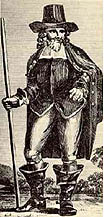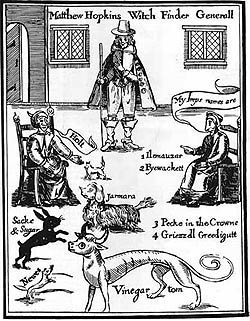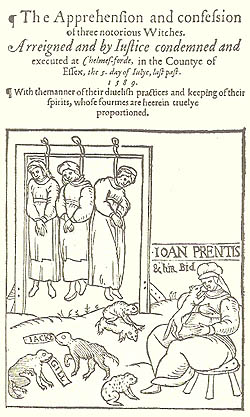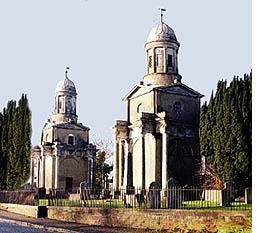Manningtree, Mistley and the Ghost of the Witchfinder General
by Dr. Gareth Evans
Claiming the title of England's smallest town, Manningtree lies on the southern bank of the river Stour, some ten miles north east of Colchester and about as far due west of Harwich.
Together with the neighbouring village of Mistley, the town is often viewed as little more than the gateway to Constable country, but both have their own rich history and architectural legacy, making them well worth taking a little time to explore.
Described in the mid-19th Century as "an improving market town", Manningtree still hosts a market in the town square on Wednesdays and Saturdays and has its own Museum, with permanent displays offering insights into the local area. Mistley was once the site of a proposed spa and though the project ultimately foundered, the village retains a number of related features. However, their main claim to fame comes from their association with Matthew Hopkins, the 17th Century Witchfinder General -- the man who claimed to hold the Devil's own list of all the witches in England.
The Rise of the Witchfinder
 The period of religious and political upheaval throughout the turbulent years of the English Civil War, coupled with the prevailing rabidly anti-Catholic feeling endemic throughout the puritan population of East Anglia, provided the back-drop to Hopkins' now infamous rise.
The period of religious and political upheaval throughout the turbulent years of the English Civil War, coupled with the prevailing rabidly anti-Catholic feeling endemic throughout the puritan population of East Anglia, provided the back-drop to Hopkins' now infamous rise.
He began his reign of terror modestly enough, denouncing his crippled neighbour, Elizabeth Clarke, as a witch. It seems likely that this was done with honest -- though somewhat misguided -- intent, for at the time, it was widely thought that there were several witches in Manningtree who regularly practised the dark arts. Although his puritan upbringing certainly gave him the motivation to battle the Devil and all his works, as an impoverished and, at least according to some accounts, rather unsuccessful lawyer, Matthew Hopkins was not slow to see the financial benefits such a career might bring. A year later, in 1645, he assumed the title of Witchfinder General and began the hunt in earnest.
 The witch hunting was to follow a depressingly familiar pattern of popular denunciation, examination, interrogation and ultimately, execution. Although the process was a judicial one, as elsewhere in Europe, there were significant differences to the way witch hunts were conducted in England. The torturing of witches to obtain their confession was a much less violent affair, with sleep depravation, the use of tight restraints to induce cramps and starvation diets being used rather than the brutal methods of the Inquisition. The sentence of death when it came, as invariably it did, was carried out not by burning, but by hanging.
The witch hunting was to follow a depressingly familiar pattern of popular denunciation, examination, interrogation and ultimately, execution. Although the process was a judicial one, as elsewhere in Europe, there were significant differences to the way witch hunts were conducted in England. The torturing of witches to obtain their confession was a much less violent affair, with sleep depravation, the use of tight restraints to induce cramps and starvation diets being used rather than the brutal methods of the Inquisition. The sentence of death when it came, as invariably it did, was carried out not by burning, but by hanging.
Like his European counterparts, Hopkins relied on "discovering" the witch-mark, a spot on the body insensible to pain -- making judicious use of a retractable spike on a spring-loaded handle to prove the point beyond doubt to any observer. He also favoured the infamous "swimming" test, binding the suspects limbs together and lowering them into the village pond. The logic was murderously simply: God's pure water would reject a witch, causing her to float, while the innocence of those who sank and drowned would assure them of a place in heaven.
Although the full total of supposed witches Hopkins and his assistant, John Stearne sent to their deaths is not certain -- estimates ranging from two to four hundred -- the numbers which are recorded tell a horrific story. Sixty-eight were killed in Bury St Edmunds alone; nineteen were hanged in a single day in Chelmsford.
 In those chaotic times, any lonely old woman who kept a pet risked a terrible fate and partly through fear, villagers could often be relied upon to act as witnesses to evil goings on. In the Manningtree area, the names of the same group of "women searchers" regularly appeared on the original indictments. Hopkins, Stearne, the local justices, clergymen and the others believed that they were performing some kind of public service, though accusations of greed and financial gain gradually gained credence, particularly given the huge recompense those involved did receive. In the spring of 1646, John Gaule, a Huntingdon parson, wrote a critical pamphlet entitled Select Cases of Conscience Towards Witches and Witchcraft in which he exposed the dubious nature of Hopkins' methods. Even as the Witchfinder General penned a pious, though lamentably feeble refutation, the popular support for both him and his cause waned. By the summer, Hopkins had retired to Manningtree, a rich man.
In those chaotic times, any lonely old woman who kept a pet risked a terrible fate and partly through fear, villagers could often be relied upon to act as witnesses to evil goings on. In the Manningtree area, the names of the same group of "women searchers" regularly appeared on the original indictments. Hopkins, Stearne, the local justices, clergymen and the others believed that they were performing some kind of public service, though accusations of greed and financial gain gradually gained credence, particularly given the huge recompense those involved did receive. In the spring of 1646, John Gaule, a Huntingdon parson, wrote a critical pamphlet entitled Select Cases of Conscience Towards Witches and Witchcraft in which he exposed the dubious nature of Hopkins' methods. Even as the Witchfinder General penned a pious, though lamentably feeble refutation, the popular support for both him and his cause waned. By the summer, Hopkins had retired to Manningtree, a rich man.
Though so much of his life is a matter of record, his end appears to have escaped chronicle, if not speculation. It has been suggested that he was himself accused of obtaining the Devil's list of all the witches in England -- of which he had boasted greatly in his earlier days -- by sorcery and forced to undergo his own trial by "swimming". In one version of the tale, he was innocent and drowned; in another, he floated and was hanged. There is, however, no record of such a trial, much less a verdict. A lonely death from illness, possibly tuberculosis, seems to have been the most probable cause of his ultimate demise. He is buried at Mistley Heath.
However, as befits this notorious character, the story does not end there, for his ghost is said to haunt Mistley pond, being most likely to be encountered around the full moon. His spectre has also been reported at a number of other places in the area. Whatever the truth of these tales, Hopkins legend has long outlived his unfortunate victims.
Architecture
 Even without its most infamous character, the architecture and social history of these two settlements would themselves make a visit worthwhile. Many of the older cottages in Manningtree and Mistley were constructed by Weavers who settled in the area during the 16th Century, having fled the Netherlands. Another distinct style of building appeared over the next hundred years with the influx of French Huguenots. Much of the Georgian architecture typical of the area arose from Richard Rigby's influence. With a vision to turn Mistley into a spa town, he commissioned the famous architect Robert Adam to realise his project. Though Rigby's public disgrace for mismanaging his office as Paymaster of the Forces meant that the plan ultimately ran out of funds, some examples of Adam's work remain, such as the Swan Fountain and Mistley Towers, part of an unfinished church demolished in 1870.
Even without its most infamous character, the architecture and social history of these two settlements would themselves make a visit worthwhile. Many of the older cottages in Manningtree and Mistley were constructed by Weavers who settled in the area during the 16th Century, having fled the Netherlands. Another distinct style of building appeared over the next hundred years with the influx of French Huguenots. Much of the Georgian architecture typical of the area arose from Richard Rigby's influence. With a vision to turn Mistley into a spa town, he commissioned the famous architect Robert Adam to realise his project. Though Rigby's public disgrace for mismanaging his office as Paymaster of the Forces meant that the plan ultimately ran out of funds, some examples of Adam's work remain, such as the Swan Fountain and Mistley Towers, part of an unfinished church demolished in 1870.
For over two centuries, the area was of great importance to the brewing and malting industries and some of the original buildings and the quay can still been seen at Mistley; Manningtree High Street, with its Victorian and Georgian facades and local Museum, also repays a visit.
The area's most famous piece of recent history, the "Secret Bunker" Museum -- a former anti-aircraft control centre built in 1951, which was designated as a Nuclear Emergency Centre during the Cold War -- closed to the public in 2002.
Location
Manningtree and Mistley are in Essex in the south east of England. They can be reached off the A137 (this is the smaller of the two main roads connecting Colchester to Ipswich -- the other being the A12 dual-carriageway, which passes some 4 miles to the west of Manningtree).
More Information:
We regret that we no longer have the resources to maintain up-to-date links and/or hours and pricing details for the various sites and attractions listed on this website. For more information about the location(s) listed above, please use your favorite search engine or visit Wikipedia.
Gareth Evans is a freelance writer and photographer, having previously worked in the private sector before lecturing at the University of Durham. Having travelled extensively, he now concentrates on writing about subjects much closer to home -- both geographically and metaphorically. He is particularly interested in myths, legends and folklore, together with the often forgotten history of the Celtic lands, especially that of his own native Wales and Scotland, his adopted home. Gareth is currently planning his next book, looking at the role of the pagan Horned God in myth and history.
Article and photos © 2005 Gareth Evans
|
